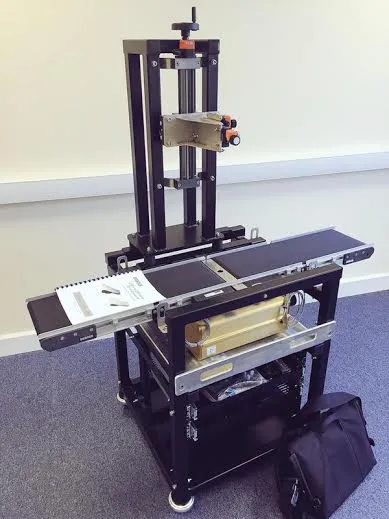These X-rays Can See Exactly What’s In Your Luggage
A new kind of X-ray machine, poised to improve airport security, can identify the material of an object passing through it
/https://tf-cmsv2-smithsonianmag-media.s3.amazonaws.com/filer/b5/aa/b5aa5ecb-9da0-45a9-bd52-3929a757cbf6/halo-x-ray-scanner.jpg)
Nervous flyers, cover your ears. According to recent research, airport screeners routinely miss dangerous items during the security process. In fact, screeners failed to identify mock bombs and weapons in 95 percent of tests conducted this year by undercover Homeland Security teams. The revelations led to the reassignment of the acting TSA director, and prompted calls for better security methods.
A team of British researchers believe they may have a solution: X-rays that don’t just show you the shape and density of what’s in luggage, they tell you exactly what it's made from. The Halo system, a collaboration between researchers at Cranfield University and Nottingham Trent University, can identify the “material signature” of different substances within milliseconds.
Current airport X-ray scanners produce images in orange, blue and green. Each color corresponds to a material category—orange means organic material (food, paper, marijuana), green is for medium-dense non-organic materials like plastic soda bottles, and blue means metals or hard plastics.
“It’s very crude,” says Paul Evans, a professor of applied imaging science at Nottingham Trent University. “It’s difficult to discriminate between threat material and benign material.”
After all, both maple syrup and nitroglycerin, an active ingredient in explosives, are thick organic liquids. Cocaine and talc are both organic powders.

The Halo uses a hollow X-ray beam, which acts as a lens to focus and magnify. Rather than producing conventional, picture-like images the way medical X-rays and current airport security X-rays do, it creates patterns. The patterns are material signatures for different substances that can then be read and interpreted by the system’s software.
“You could use it in a completely automated manner, which is the concept behind the current product,” Evans says. “You don’t need humans.”
In fact, the current prototype of the Halo doesn’t even have a screen.
“It produces a diffraction image, an abstracted pattern of radiation,” Evans says. “You don’t need a human operator to look at these signals because it’s a signal processing job.”
In an airport context, the machine could set off an alarm when it recognized a dangerous material. It could work in conjunction with a traditional 3D X-ray image, to show security workers where in the luggage the threat is located. Research on Halo was funded in part by the United Kingdom's Home Office, the governmental agency dealing with terrorism and security issues.
The current Halo prototype, however, is too small for luggage. It can be used to scan small packages or electronics. The team hopes to have it on the market “very, very shortly,” Evans says, though details are not yet available. A machine big enough to read luggage may follow within the next three or four years.
The researchers also see potential for Halo to be used in areas other than airport security. In the medical world, for example, the machine could take bone density measurements. It could also be useful in manufacturing, to diagnose problems on production lines without taking apart equipment.
/https://tf-cmsv2-smithsonianmag-media.s3.amazonaws.com/accounts/headshot/matchar.png)
/https://tf-cmsv2-smithsonianmag-media.s3.amazonaws.com/accounts/headshot/matchar.png)